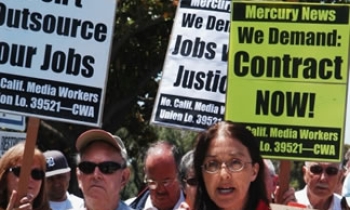The survival of newspapers will depend on how quickly and effectively they adapt to the digital age and that too through new business models, two of the world's most revered newspaper specialists have predicted.

"The new-technology competitors of print are threatening to be much more socially disruptive than radio and television were because their utility as advertising media undermines the economic model that supports public-service journalism. Ink on paper will survive in new business models. They won’t be as profitable as the old model, but they will persist in new niches," envisages Philip Meyer, Knight Chair of Journalism, University of North Carolina at Chapel Hill, US.
Roy Greenslade, Professor of Journalism at London’s City University and a media commentator since 1992, agrees that the digital revolution is having a more marked effect on sales than all the previous inventions put together, and cautions, "This is a challenge to newspapers to change, necessitating both depth and speed of thought. If that response is sensible it need not mean the end of newspapers as a medium. However, there may be fewer titles and the ones that survive will have to adapt once more. Even if I was to accept that the press is dying (and I do not) I also believe that death is not as close as the doom-mongers predict."
Meyer and Greenslade's predictions have been made in Trends in Newsrooms 2006 published recently by the World Editors Forum. The report, the second in the yearly series, looks at the most pressing issues facing newspaper editorial hands in the digital age. The 150-page report is based on the best articles from Editors Weblog (www.editorsweblog.org), an online publication of the World Editors Forum that tracks and analyses the major stories affecting newsrooms around the world.

Newspapers 2015: Towards a challenging future, the introduction to the report, is essentially a fusion of two separate interviews with Meyer and Greenslade. And neither has forecast the immediate death of newspapers.
Afirms Greenslade, "Hard-headed realism dictates that we save the print form because the kind of journalism it has created is valuable to society (and by that, I mean valuable to the operation of a liberal democratic state). My belief is that organised, structured journalism produced by educated, trained professionals remains the best way to hold governments, institutions and businesses to account."
Meyer is not worried so much about newspapers petering out as he is about the possibility that journalism itself might disappear. He says, "James Madison warned his fellow Americans about 'the men of factious temper' who would keep us distracted from the common good. The development of newspapers with broad appeal early in the 19th century helped keep the country together. What is hard to see now is the development of a new economic model for news that will fulfill that same function."
"The historic role of newspapers," maintains Greenslade, "has been as organs of democracy. Now, within democracies, newspapers are the main media form holding governments and big business accountable for its actions. Journalists working for TV and radio have always tended to play a supporting role to newspaper journalists who have a lengthy track record in breaking stories and in campaigning on a daily basis. The watchdog role depends on the existence of newspapers."

Meyer goes a step further as he contends that if newspapers abandon investigative journalism, other institutions will take up the slack. He cites the examples of nongovernmental organisations like the Centre for Responsive Politics and the Center for Public Integrity, and individuals like Barry Sussman, who now runs the Nieman Watchdog Project, and says, " Democracy is endlessly inventive… We should not be dismayed by the passive extrapolation of existing trends. The future can be what we make of it." In fact, he asserts, "Investigative journalism is still necessary, and the marketplace will find a way to support it."
While Meyer seems to suggest that democracy will find its own kind of investigative journalism, Greenslade asserts, " Newspapers, because they act as a forum for the most reliable news-gathering and informed opinion, remain the most effective watchdog. If they disappear then democracy itself is in peril."
Both talk about the crisis in journalism, but perspectives are slightly different. Greenslade notes the adverse effect that the Internet had on advertising revenues for newspapers in Britain, and concludes, " With a continuing fall in circulation revenue as well, the financial situation at most of leading serious newspapers is desperate. Four of the five titles – The Times, Financial Times, The Independent and The Guardian – are no longer returning profits. The Daily Telegraph is profitable but has seen the rate of profit decline substantially in recent years. Journalism is therefore in crisis."
Meyer feels the traditional forms, as a matter of fact, are in crisis. "The trick is to save journalism by helping its transition to new forms. That’s why the subtitle of my book is 'Saving Journalism in the Information Age.' Newspapers in the US are better positioned than those in many parts of the world because they are local. Specialised information has adapted better to new technology than more general information, and that is why community newspapers have fared better than large metropolitan or national newspapers. Developed countries without a strong local newspaper tradition might find opportunities there," he reckons.
The two also offer different perspectives on how the Internet is affecting the very practice of journalism. Greenslade is noncommittal and strikes a note of caution, "In the midst of a revolution it is always difficult to forecast its outcome. We are seeing, day by day, a growing use of the Internet as a source, and an archival resource, for print journalists. Similarly, traditional sources for journalists are using the Net themselves, widening their audience for material once vouchsafed only to the 'professionals'. This is speeding up the news cycle, but it is unclear yet just how much effect it has had on the practice of print journalism. Indeed, we are at that stage in the revolution when people are tending to make almost daily discoveries."

Meyer, on the other hand, says, "The online conversation deprives traditional journalism of its agenda-setting power. This power was used in both positive and negative ways. One of its applications was to keep the public from thinking about holes and inadequacies in the conventional news report. Now it is under greater scrutiny, and the value system is slowly changing in ways that are good for the pubic and good for journalism." Two areas in which changes are happenning, he points out, are the demand for greater transparency, and decreased tolerance for plagiarism and fictionalising in journalistic accounts.
Both Meyer and Greenslade dismiss the contention that older journalists and editors, declared by some to be out of touch, are responsible for circulation declines. Greenslade does say that to an extent it may be the fault of journalists, though owners are hardly blameless either. "They accepted profits in the good times without thinking of the consequences for the future." He goes further and says, "Despite isolated terrorist outrages, people in the West feel that they under no real threat. News has therefore become largely irrelevant to vast numbers of people whose only nexus is money. Running in parallel has been a rise of individualism and consequent decline in community (and community spirit). On a national scale, this has created a narrow and inward-looking population."
Meyer believes it is disruptive technology which is the global cause for dwindling circulation figures. "In the US at least, newspapers have been so successful with so little effort for so many years that they have developed a risk-averse culture that leaves them poorly positioned to innovate. They would rather harvest their goodwill by raising prices and reducing quality than invest in new ways of presenting news and advertising. There will be meaningful innovation, of course, but it is more likely to come from outside the traditional newspaper industry, as Google and Craig Newmark are already demonstrating. The problem, of course, is to preserve the social responsibility function in these new forms," he says.









